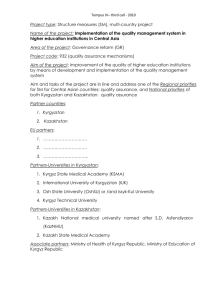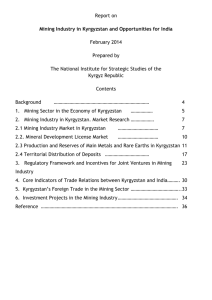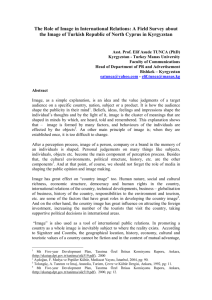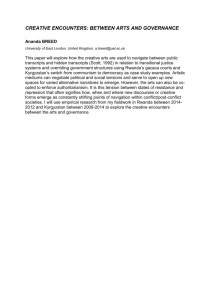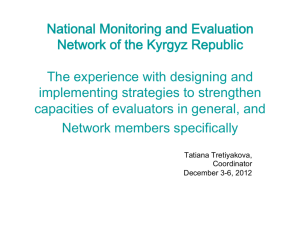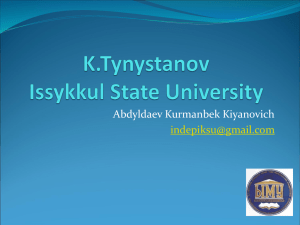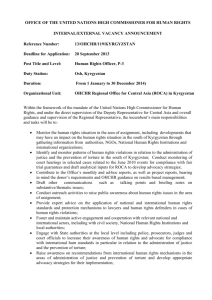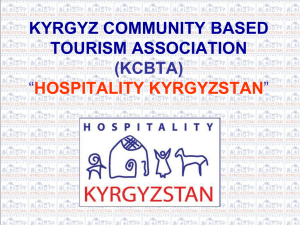institutional interrelations among the state, business and civic sector
advertisement
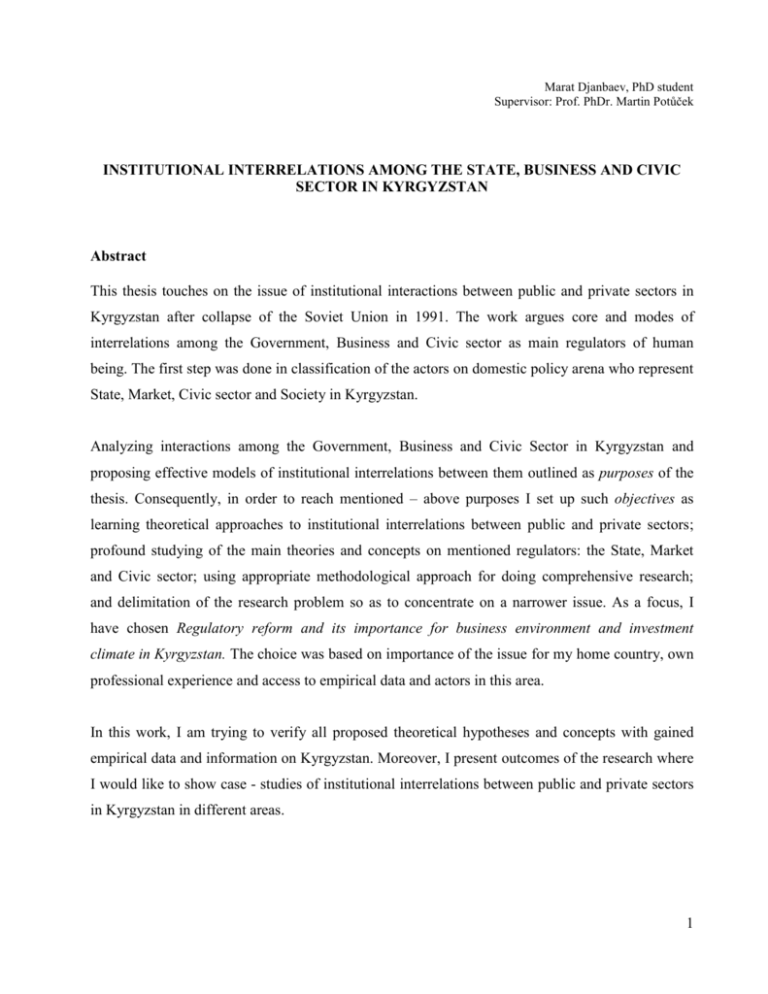
Marat Djanbaev, PhD student Supervisor: Prof. PhDr. Martin Potůček INSTITUTIONAL INTERRELATIONS AMONG THE STATE, BUSINESS AND CIVIC SECTOR IN KYRGYZSTAN Abstract This thesis touches on the issue of institutional interactions between public and private sectors in Kyrgyzstan after collapse of the Soviet Union in 1991. The work argues core and modes of interrelations among the Government, Business and Civic sector as main regulators of human being. The first step was done in classification of the actors on domestic policy arena who represent State, Market, Civic sector and Society in Kyrgyzstan. Analyzing interactions among the Government, Business and Civic Sector in Kyrgyzstan and proposing effective models of institutional interrelations between them outlined as purposes of the thesis. Consequently, in order to reach mentioned – above purposes I set up such objectives as learning theoretical approaches to institutional interrelations between public and private sectors; profound studying of the main theories and concepts on mentioned regulators: the State, Market and Civic sector; using appropriate methodological approach for doing comprehensive research; and delimitation of the research problem so as to concentrate on a narrower issue. As a focus, I have chosen Regulatory reform and its importance for business environment and investment climate in Kyrgyzstan. The choice was based on importance of the issue for my home country, own professional experience and access to empirical data and actors in this area. In this work, I am trying to verify all proposed theoretical hypotheses and concepts with gained empirical data and information on Kyrgyzstan. Moreover, I present outcomes of the research where I would like to show case - studies of institutional interrelations between public and private sectors in Kyrgyzstan in different areas. 1 Content Introduction I. II. III. Purpose and objectives of the thesis Research questions Theoretical dimension of the thesis a. Theoretical hypotheses IV. V. VI. Methodological approach Delimitation of the research problem Outcomes of the empirical research in Kyrgyzstan a. Tax reform b. Law on Inspections c. Improving Kyrgyzstan’s standings at international ratings Conclusion References 2 “We consider a man who takes no interest in the state not as harmless, but as useless, and although only a few may originate a policy, we are all able to judge it” Pericles (antique Greek philosopher) INTRODUCTION Following the disintegration of the Soviet Union, the Kyrgyz Republic as a post-communist country moved towards democracy and free market economy. At the rhetorical level, the newly emerged country declared its commitment to values and principles of free market, democracy and civil society. Although at the policy level, the Kyrgyz Republic conducted a number of sound reforms aimed at fostering free market economy, redesigning state institutions and empowering private sector, it still remains as a country with relatively centralized, tribal and clan political system, weak public administration and inefficient economy. In the proposed thesis, my mission is to research institutional interrelations among the Government, Business and Civic Sector in Kyrgyzstan as main regulators of human’s life and public affairs. The research on these regulators in such developed societies as the USA, Continental Europe and Japan has proven that successfulness and effectiveness of Governance depend on regulators and modes of their interactions. For that reason, I took the most prominent theoretical and conceptual approaches on the issue and I am trying to apply them into Kyrgyzstani realities. At the same time, outcomes of my empirical research on regulatory reform toward business environment and investment climate in Kyrgyzstan for past 3 years and relevant case – studies will either verify or falsify applied theoretical hypotheses. In the final analysis, it will help me in identifying and proposing a definite hypothesis of my dissertation. The thesis also comprises of research questions, methodological approach, delimitation of the research problem; results of the empirical research in areas of Tax reform, Law on Inspections and improving business environment and investment climate by promoting Kyrgyzstan in such well recognized international ratings as Index of Economic Freedom and Doing Business. 3 I. PURPOSES AND OBJECTIVES OF THE THESIS I outlined the following purposes and objectives for my PhD thesis. Purposes • Analyzing interactions among the Government, Business and Civic Sector in Kyrgyzstan. • Proposing effective models of institutional interrelations between public and private sectors in Kyrgyzstan. Objectives These objectives will help me to reach the mentioned – above purposes: - Learning theoretical approaches to institutional interrelations between public and private sectors. - Profound studying of the main theories and concepts on such regulators as: the State, Market and Civic sector. - Using appropriate methodological approach for doing comprehensive research. - Delimitation of the research problem in order to focus on narrower issue. 4 II. RESEARCH QUESTIONS 1. What are the main actors on policy arena who define policy agenda and modes of interrelations between public and private sectors in Kyrgyzstan? 2. Do political system, regime and legislative background allow effective interactions between public and private sectors in Kyrgyzstan? 3. What are the factors inducing and influencing interrelations among the Government, Business and Civic sector in Kyrgyzstan? 4. Which theory and/or concept are more applicable in designing better models of interrelations between public and private sectors in Kyrgyzstan? CLASSIFICATION OF THE ACTORS State In its etymology, the state implies a wide range of definitions. But within this research, the state means legitimate three branches of power with its institutions in the Kyrgyz Republic: the President and Government; unicameral Parliament and Court system. In the regard to business and civic sector, the state always has dual position: 1) as a sole legitimate authority that establishes legal rules and frameworks for society, and 2) as an equal actor of interrelational process as well as private commercial and civic sectors. Private commercial sector – represented mainly by business and professional associations, private entrepreneurs (according to research on business – associations in Kyrgyzstan done by Eurasia Foundation in 2006, there are 35 officially registered business – associations). Civic sector and society – non – governmental, non – profit organizations and informal actors (clans, religious movements). According to data of Ministry of Justice of the Kyrgyz Republic, there were registered 10 000 non – governmental organizations in Kyrgyzstan in 2006. 5 III. THEORETICAL DIMENSION In my work, I referred to following theories and concepts: Theory of the Government, Market and Civic Sector as regulators of society (Lindblom 1977), Multi–Dimensional Concept of Governance (Potůček 2007), Theory of Neo - Corporatism (Schmitter, Streeck 1999). At the same time, I am planning to utilize such advanced theoretical frameworks as Actor–Centered Institutionalism (Scharpf 1997) and Concept of New Public Management (Osborne, Gaebler 1992) in final part of my dissertation when I am to propose definite modes of interaction for Kyrgyzstani regulators. Theory of the Government, Market and Civic Sector as regulators of society (Lindblom) Theory of the Government, Market and Civic Sectors as regulators of society by Lindblom is one of core theoretical dimensions that I applied to my thesis because of holistic character and universal approach. Strictly speaking, I will exploit it as the basic and fundamental theory of my thesis. Charles Lindblom (1977) proposes to consider the functioning of global societies on the basis of definitions of the following elementary political and economic mechanisms that influence and condition human lives and societies: 1) government as the expression of political power, 2) the market as a medium of exchange; and 3) indoctrination. Typical agents of indoctrination are educational systems and the mass media, because indoctrination means ideology in terms of politics and it refers to advertisement in terms of market. Above all, it is necessary to define environment in which all regulators are interacting with each other. According to Lindblom, there are two models of society. Model I might be called an intellectually guided society. It derives from a buoyant or optimistic view of man’s intellectual capacities. Model II postulates other forms of guidance for society due to scarcity of man’s intellectual abilities. In terms of social interactions, Model I proposes that elite would study the question in an attempt to find correct decisions in order to solve problems. Economic planning of the communist variety is the obvious example. In Model II, it would establish an interactive and cooperative process that would make the diagnostic study unnecessary. For instance, the market system is the clear example 6 where it can set up a tripartite commission of representatives of workers, managers and public officers and allow negotiation among them to settle the question. It is urgent to sub – divide private sector into private commercial sector (business) and private informal sector (society, family, community, clans). Table 1: Types of sectors regulating people’s action Source: Wolfenden Commission (1978) In order to verify application of this theory to Kyrgyzstani experience, I referred to political, legislative and institutional backgrounds where Constitution of the Kyrgyz Republic declares democratic political regime based on three branches of power (Executive, Legislative, Court); free market economy and civil society. Thus, according to classification of Lindblom and Wolfenden Commission, regulators of human lives in Kyrgyzstan look as following (see table 1.1) Table 2. Regulators in Kyrgyzstan State The President, Government, Parliament, Court Private commercial sector (business) Business – associations, trade – unions, private entrepreneurs Civic sector NGO’s and international organizations Private informal sector (society) Clans and tribes, religious movements, crime If I apply Lindblom’s approach on defining models of society, Kyrgyzstan belongs to Model II which implies participatory democracy and institutional interactions among mentioned – above 7 regulators. Further, in delimitation of the research problem and case – studies I will speak about such interactions in Kyrgyzstan in more detail and verify belonging of Kyrgyzstan to Model II. Multi–Dimensional Concept of Governance (Potůček) I decided to apply this concept because of multi – dimensional approach to traditional Neo – Weberian concept of state. The concept brings new approaches to classical bureaucratic administration by subdividing governance into three different and interconnected layers. Dimension I. Vertical layers of Governance This dimension shows us traditional bureaucratic “Top – down” scheme of governance represented in Kyrgyzstan by the Government, oblast administration (regional units on macro level), rayon administration (regional units on micro level) and aiyl okmotu (local administration on the lowest level). Dimension II. Regulators – market, state and civic sector The dimension is based on market – government– civic sector interface (figure 1.) that I discussed in depth in previous theoretical concept proposed by Lindblom. Nevertheless, I would like to enrich verification of the concept by adding table with criteria distinguishing the public, private commercial and civic sectors. Figure 1. The concept of governance based on market, state and civic sector interface Source: Potucek (2008) 8 Table 3. Criteria Distinguishing the Public, Private Commercial and Civic sectors Criterion Sector Public sector Private commercial sector Private civic sector Political power Government power Individual freedom Individual freedom and public power Consumption and Public consumption and Private consumption and Public private investment investment investment consumption and investment Characteristics of Political or administrative Private decision – making decision making decision – making Public - private decision making Provision of goods, Public goods, benefits and Private goods, benefits and benefits and services services services Public – private goods, benefits and services Ownership Public ownership Private ownership Employment Public sector Private sector Public – private ownership Private sector Source: Lane (1993), corrected Dimension III. Actors’ networks and networking The main message of this dimension is horizontal and mostly informal interactions among regulators. Usually, horizontal layer of cooperative ties between regulators emerged as a response to definite agenda, issue, problem or interest. For that reason, the dimension is more result – driven rather than process – oriented. The dimension is easily verified in Kyrgyzstan by recently emerged different horizontal interrelations of the Government, business community and civic organizations within such public bodies on national levels, for example: Constitutional Council of the Kyrgyz Republic between 2005 – 2007, Working group on elaborating new version of Tax Code between 2004 – 2008, Public Council under Custom Service of the Kyrgyz Republic and Advisory Council under the Ministry of Economic Development and Trade of the Kyrgyz Republic. Example: Public Council under Custom Service of the Kyrgyz Republic Custom and tax agencies are one of the corruptive bodies in Kyrgyzstan due to contact with custom and tax – payers. In 1999, the Government established special public council under Custom Service with participation of the Custom officers, businessmen and representatives of non – governmental organizations that deal with custom and tax issues. The main goal of this Council was providing transparency and accountability of the Custom service and fighting with corruption within it. Public Council conducts regular meetings and public hearings in order to discuss appeals, complaints and recommendations of business companies, private entrepreneurs or civic organizations. Source: bulletin of National Alliance of Business Associations in Kyrgyzstan (2008) 9 Figure 2. Structure of Constitutional Council in Kyrgyzstan 2005 - 2007 Constitutional Council – 114 members NGOs, business community, political parties – 57 members President – Chairman and moderator Working group (drafts project of Constitution) The Government (10), Parliament (37), Constitutional and Supreme Court (10) – 57 members Proposal of revised Constitution Approved by Parliament Approved by referendum (Option 1) (Option 2) Theory of Neo - Corporatism (Schmitter, Streeck) Theory of Neo - Corporatism or Liberal Corporatism declares main principles of necessity of partnership between public and private sectors due to their interdependent interests. Corporatism is a widespread concept in democratic societies with free market economy. The main core of the concept of Corporatism are bargaining, negotiating and finally reaching consensus among the state, representatives of non – profit sector and business in solving common issues. For example, tripartite commissions including Government bodies, trade unions and business companies in arranging work hours, work conditions and salaries. The conceptual definition of corporatism by classics of this concept Schmitter and Streeck says that: “Unlike the sharp division in liberal democratic theory between hierarchical state authority and the voluntary organization of civil society, corporatist theory and practice blur the boundary between state and society as the state shares authority with private interest associations, using the latter as agents of public policy by coordinating their behavior or delegating public functions and decisions to them”. 10 The main distinction and feature of Corporatism from other theories and concepts is emerging organized interests and institutional approach of private sector (commercial and non - commercial) from bottom to up. Usually, the state executes its policy from the top of power’s pyramid down. In case of Corporatism, private organizations offer the Government their own view and proposals on policy – making and policy – implementing processes. Potůček (1999) proposes that Corporatism tends to emerge as a pragmatic political response to the dysfunctioning of democratic capitalism. Corporatism may be introduced from below, if civic sector institutions convince government that they should be utilized as means of responding to a segment of public interest that is better satisfied when government promotes specific civic – sector interests. Recently, there have emerged two absolutely new public bodies in Kyrgyzstan that were empowered and given a force by the Government to execute and monitor their decisions in order to implement policies approved by actors within these public – private interest organizations: Public Chamber of the Kyrgyz Republic and Investment Council under the President of the Kyrgyz Republic. • • Public Chamber of the Kyrgyz Republic Established in December 2008 by the President with involvement of civic organizations, informal movements and leaders, business – associations for defining policy agendas and monitoring of their implementation. Investment Council under the President of the Kyrgyz Republic The Council includes the President, Prime - Minister, key economic ministers, leading business associations and parliament deputies for elaborating policies and monitoring their implementation in business regulatory reforms. Its decisions and directives possess mandatory power to all Government bodies. Difference of their prerogative and power from typical public – private partnerships with consultancy and advisory functions that were described in previous concepts gives an idea that there is a shift from pluralistic to corporatist form of interactions between public and private sectors in Kyrgyzstan. Formally, it sounds as a liberal corporatist concept in Kyrgyzstan but in fact, I have a doubt on impartiality of Public Chamber of the Kyrgyz Republic when it is supposed to be single public council, which defines national agendas and controls execution of state policies by the Government and its institutions. If we take into consideration the fact that the Government regulates and restricts participation of civic organizations and business – associations in Public Chamber of the Kyrgyz Republic by imposing its will on agenda and policy decision processes, 11 such practice will shift to “state corporatism” according to Schmitter when he differentiated between corporatism in market economies and totalitarian regimes in terms of “social corporatism” and “government corporatism”. IV. METHODOLOGICAL APPROACH I exploited several methodological approaches and data for profound learning of the issue. First of all, I searched, reviewed and collected a bulk of literature – relevant books recommended by my supervisor and other professors; articles in scientific magazines and papers. It is urgent to notice lack and absence of literature and data on regulators and their interrelations in Kyrgyzstan. Kyrgyzstan is a relatively young country with scarce academic and methodological base in Social Sciences where many Kyrgyz scholars and students usually refer to Russian and Western sources. For instance, I mostly studied English and Czech literature and data provided by our department, CESES and faculty. Analytical method, which was one of the most important methods in reviewing collected literature and data, helped me in choosing theoretical framework “Polity, Politics, Policy” (Fiala, Schubert 2000) as a basic methodological tool for designing my research. Due to continued professional activity with leading business – associations in Kyrgyzstan (Bishkek Business Club www.bdk.kg and National Alliance of Business Associations www.naba.org.kg), I could collect and obtain needed empirical data and policy documents in the area of regulatory reforms toward improving business environment and investment climate in Kyrgyzstan. In particular, my work as a strategic adviser for such implemented projects and advocacy campaigns as “Reform of Tax Legislation in Kyrgyzstan”, “Strengthening advocacy of business associations and improving entrepreneurial climate in Kyrgyzstan; creating one voice of business”, “Reforming Law on Inspections of the Kyrgyz Republic”, “Private Property Protection in Kyrgyzstan” and “Promoting Kyrgyzstan’s standings at international ratings” helped me in interviewing the main actors of interrelation processes in the Government, business – community and NGOs. Then, I conducted primary and secondary analysis of policy documents and national legislation; event and content analysis of the actor’s speeches and their interviews to mass – media. Other very important sources of data for my research were several surveys conducted within mentioned projects. For example, Bishkek Business Club conducted surveys on Tax reform, Law on Inspections and Private Property Protection. 12 Definitely, comparative analysis with international experience and case – studies will enrich outcomes of my research. Studying in a member country of the European Union made me learn European experience in regulator’s interactions and their modes. Besides, a one-term internship at the U.S. Chamber of Commerce in Washington D.C and at a non – profit organization in Colorado Springs, state of Colorado enabled me to have a general overview on American experience on building institutional interrelations between public and private sectors. V. DELIMITATION OF THE RESEARCH PROBLEM I defined Regulatory reform and its importance for business environment and investment climate in Kyrgyzstan as a narrower subject or dimension of research problem. The research problem was delimitated in the framework of the general topic of my research issue “Institutional interrelations among the State, Business and Civic sector in Kyrgyzstan”. Choosing the research problem was based on importance of the issue for home – country, my professional experience and access to relevant empirical data in Kyrgyzstan. Definition of Regulatory reform of business environment In the framework of defining of the term, I formulated such cognitive questions as what does regulatory reform mean and why do we need to de – regulate the business environment? Outcomes of the research brought me to following points in order to answer these questions. What does regulatory reform mean? - Simplifying business registration and licensing procedures - Improving tax policies and its administration - Improving labor legislation and its administration - Improving the overall quality of regulatory governance - Simplifying and speeding up access to commercial courts and alternative dispute resolution mechanisms - Broadening public – private dialogue through public policy standards - Improving access to market information and access to finance 13 Why do we need to de – regulate the business environment? - To enable businesses to compete better in domestic and international markets by reducing the cost of doing business - To increase employment opportunities - To promote public and private governance that leads to economic growth - To reduce corruption and unfair monopoly - To transform the use of personal contacts and patronage systems to systems that are based on a market – neutral set of rules to enable entry and market competition Definition of Business Environment The Donor Committee for Enterprise Development defines business environment as “a complex of policy, legal, institutional, and regulatory conditions that govern business activities. It is a sub-set of the investment climate and includes the administration and enforcement mechanisms established to implement government policy, as well as the institutional arrangements that influence the way key actors operate (e.g., government agencies, regulatory authorities, and business membership organizations including businesswomen associations, civil society organizations, trade unions, etc.”(Supporting business environment reforms. Practical guidance for development agencies. 2008. http://www.businessenvironment.org/dyn/be/BEsearch.home). Figure 3. Defining the business environment Source: Supporting business environment reforms; practical guidance for development agencies/ www.businessenvironment.org 14 There are three main pillars of business environment that lead to its improvement. In the figure above and in the description of following pillars, it is seen how institutional interrelations between the Government and private sector influence business environment and investment climate. Policy framework Improving national policies that promote competition, open markets and the general conditions for doing business Legal and regulatory reform Improving national laws and regulations that affect the establishment, operation and closure of businesses Business regulations: tax legislation and administration, labor laws and regulation, trade regulations, custom administration Institutional arrangements Public – private dialogue or partnership Regulatory Governance Capacity Building VI. OUTCOMES OF THE EMPIRICIAL RESEARCH IN KYRGYZSTAN As I mentioned previously, I was involved in several policy research projects and advocacy campaigns in improving business environment and investment climate in Kyrgyzstan. In this thesis, I would like to highlight some preliminary outcomes of the research that touched on reforming national Tax Code, adopting single Law on Inspections to business enterprises and entrepreneurs, private property protection, improving Kyrgyzstan’s standings at international ratings: Doing Business, Index of Economic Freedom. Reforming national Tax Legislation Necessity to reform Tax Code in Kyrgyzstan was acknowledged by the both sides: the Government and business – community. The President of the Kyrgyz Republic signed a decree in January 2004 about reform of Tax Code by using standards of public policy discussions and established Working group on elaboration of new Tax Code where representatives of the Government, Parliament, business – associations and civic organizations were given equal rights of group members in order to propose new Tax Legislation. It was the first time when the Kyrgyz Government decided to work out such an important issue publicly with involvement of as much as possible stakeholders. During four years of work of the Working group, each side has shown and formulated its position on the issue. 15 Position of business and civic sector – Joint efforts of business and civic sector were transformed into single coalition “For Fair Taxation” with 23 business – associations and NGOs all over Kyrgyzstan. – The Coalition asked simplification of Tax Code with clear tax administration; reduce VAT from 20% to 10%; introduce presumption of innocence for tax payers and tax incentives for exporters, business beginners and non – profit organizations; introduce “flat tax” in the nearest future – The Coalition conducted survey on the national level among businesses and NGOs in order to show imperfection of tax administration and its burden on private sector. Figure 4. Public services that extort bribes Source: “Review of the investment climate”, 2005 Position of the Government – The Government was aware of imperfect Tax legislation adopted in 1996, which caused complexity of the legislation and corruption in fiscal system. – The Government established official working group on elaborating new version of the Tax Code with involvement of ministers (economy and trade, finance), members of Parliament, and few representatives from business and civic sector. – The Government insisted on having more comprehensive Code with 400 articles instead of existing 200. 16 – The Government agreed on decrease of VAT from 20% to 10%, but it was against any forms of incentives due to risk of budget losses and absence of substitutions. – The Government introduced e – concept of tax reports to decrease considerably real contact between tax inspector and tax payer. It is supposed to gradually promote system of virtual secured tax reports through internet. Adopting single Law on Inspections to business enterprises (position of private sector and the Government) On May 29, 2007, President of the Kyrgyz Republic signed the Law on Inspection to business enterprises that approved single legislation to regulation of business environment in Kyrgyzstan. Before adoption of the Law, business – associations in cooperation with Ministry of Economic Development and Trade of the Kyrgyz Republic did research on quantities and impacts of inspections to private sector. Results of the research amazed not only private sector and international organizations but also the President. Because the Government conducted 23 918 inspections and spent roughly 2,2 million US dollars (USD) from the state budget and collected only 80 thousand USD in 2006. Effectiveness of the overall inspections by the Government in 2006 was – 2,2 million USD or – 0,067 % to GDP. Moreover, before the emerging of a single Law on Inspections, each ministry or agency of the Government could initiate and impose inspections according to own regulations. The signed new Law on Inspections introduced three absolutely new ideas: 1. One – stop office registration principle when enterprises can register or liquidate their businesses only in one designated office. 2. Length of annual inspections cannot exceed more than 15 days for big enterprises and 5 days for small and medium sized enterprises. 3. The President declared a Moratorium to all kinds of business inspections until December 2007 in order to see efficiency of the Government inspections and to foster business environment improvement. In 2008, after expiration of the term of Moratorium, National Alliance of Business Associations’ survey among entrepreneurs has shown that enterprises cut down expenses roughly 7 – 10% from their money turnover1. At the same time, the State Committee of Tax Service officially declared that tax collections to the state budget increased by half or for 50% as compared with last year and 1 www.naba.org.kg/library 17 accounted 100,8% to planned amount. Tax proceeds to the budget have grown for 47,7% in comparison with same period of time in 20072. Improving Kyrgyzstan’s standings at international ratings For a small republic with $ 1813 GDP per capita, weak industries and lack of mineral resources, it is very urgent to develop small and medium sized businesses that provide sustainability of the national economy, reducing poverty and might perform the role of economic engine in the future. However, development of small and medium enterprises and attracting foreign direct investments depend on predictable and comfortable business and investment environment. For that reason, it is crucial to develop Kyrgyzstan’s standings at internationally recognized ratings. As a matter of fact, almost each prospective investor who is going to invest or launch business projects in new markets rely on the World Bank’s annual rating on the ease of doing business (Doing Business), and Rating of Heritage Foundation with Wall Street Journal on Index of Economic Freedom throughout the world with measuring 10 main freedoms. Index of Economic Freedom Definition of economic freedom by Heritage Foundation - economic freedom is the fundamental right of every human to control his or her own labor and property. In an economically free society, individuals are free to work, produce, consume, and invest in any way they please, with that freedom both protected by the state and unconstrained by the state. In economically free societies, governments allow labor, capital and goods to move freely, and refrain from coercion or constraint of liberty beyond the extent necessary to protect and maintain liberty itself. Methodology of the Index of Economic Freedom (freedoms) Business Freedom Trade Freedom Fiscal Freedom Government Size Monetary Freedom Investment Freedom Financial Freedom Property Rights Freedom Freedom from Corruption Labor Freedom Source: Heritage Foundation, http://www.heritage.org Kyrgyzstan is improving its standing at the Index of Economic Freedom gradually. According to data of the Heritage Foundation, Kyrgyzstan holds 74th position with 61.8 scores and left behind 2 www.akipress.org (14.11.2008) 18 such economies as Turkey, Poland and Macedonia. Kyrgyzstan improved its standing in comparison with last year for 0,7 scores and the current overall score slightly above world average. Heritage Foundation noted that Kyrgyzstan did well in business freedom and trade freedom but it remains worse at private property right and freedom from corruption. Figure 5. Dynamics of Kyrgyzstan at the Index of Economic Freedom 1998 - 2007 Source: Heritage Foundation Annual Reports, http://www.heritage.org/Index/Explore.aspx?view=by-region-country-year Doing Business Doing Business covers 181 economies - including small economies and some of the poorest ones, for which little or no data are available in other data sets. The Doing Business data are based on domestic laws and regulations as well as administrative requirements. The rating provides a quantitative measure of regulations for starting a business, dealing with construction permits, employing workers, registering property, getting credit, protecting investors, paying taxes, trading across borders, enforcing contracts and closing a business—as they apply to domestic small and medium-size enterprises. A fundamental premise of Doing Business is that economic activity requires good rules. These include rules that establish and clarify property rights 19 and reduce the costs of resolving disputes, rules that increase the predictability of economic interactions and rules that provide contractual partners with core protections against abuse3. Methodology of Doing Business (indicators) – – – – – – – – – – Starting a Business Dealing with Construction permits Employing Workers Registering Property Getting credit Protecting Investors Paying Taxes Trading across Borders Enforcing Contracts Closing a Business Source: The World Bank, Easy of Doing Business http://www.doingbusiness.org Indeed, impressive shift of Kyrgyzstan from 99th position in 2007 to 68th position in 2009 within Doing Business ranking is the contribution of the private sector and the World Bank’s Doing Business project in Kyrgyzstan. The Government of the Kyrgyz Republic started paying attention to the importance of standing of Kyrgyzstan in Doing Business after grass – root advocacy campaigns by local business – associations and foreign investors, who managed to convince how important it is and beneficial to deregulate the national economy. The President established Working group on improving of Kyrgyzstan’s standing at Doing Business rating in April 2007. The Working group comprised of key economic ministries of the Government, leading business – associations (Bishkek Business Club, International Business Council), civic organizations and World Bank’s office in Bishkek. The Working group scrutinized national legislation in order to find loopholes according to methodology of Doing Business and drafted legislation to propose changes and amendments by Parliament and the Government. According to fresh data of the World Bank, The Kyrgyz Republic is the most advanced country in Central Asian region and among the top 3 reformist economies in Doing Business ranking of 2009 (see table 4). 3 http://doingbusiness.org/documents/DB09_About.pdf 20 Figure 6. Dynamic of Kyrgyzstan’s development in Doing Business 2008 - 2009 Source: Doing Business Report 2009, the World Bank Table 4. The top 10 reformers in 2007/2008 Source: Doing Business Report 2009, http://doingbusiness.org/Documents/FullReport/2009/DB_2009_English.pdf 21 CONCLUSION The conclusion recapitulates the main outcomes and findings of the thesis. In order to be specific with results and conclusions, I refer to initial purposes and objectives of my thesis along with research questions. My purposes were to analyze interactions among the Government, Business and Civic Sector in Kyrgyzstan and to propose effective models of institutional interrelations between public and private sectors in Kyrgyzstan. In the thesis, I proposed theoretical framework that I applied and I am going to follow it through the entire research to design the final version of my dissertation proposal. I used the method of verification of chosen theoretical approaches with gained empirical data and information during my work in Kyrgyzstan. I verified Theory of State, Market and Civic Sector as main regulators of human’s life (Lindblom), Multi – Dimensional Concept of Governance (Potůček) and Theory of Neo – Corporatism (Schmitter, Streeck). In my opinion, such practice of verifications will make me closer to advance main hypotheses of the research. So far, I have not reached second purpose yet where I am to propose effective models of institutional interrelations between public and private sectors in Kyrgyzstan. In pursuing of the second purpose, I will be guided by results of my comparative analysis and learned case studies during PhD studies at Charles University and internship in the USA. Main theoretical pillars of the second purpose will be Actor – centered institutionalism (Scharpf 1997) and New Public Management (Osborne, Gaebler 1992). In particular, if results of comparative analysis and case studies help me in designing and elaborating specific models and modes of institutional interrelations among the Government, Business and Civic Sector in Kyrgyzstan, chosen conceptual frameworks would help me in verification of hypotheses in order to propose realistic and feasible recommendations. Another important key - finding of my thesis is that delimitation of the research problem to the issue of regulatory reform and its importance for business environment in Kyrgyzstan and relevant outcomes of empirical research described in the body of the thesis assists me to answer three initial cognitive questions out of four. 22 REFERENCES Books and articles 1. Axelrod, R.M. (1984). The Evolution of Cooperation. New York: Basic Books. 2. Axelrod, R.M. (1997). The Complexity of Cooperation: Agent – based model of competition and collaboration. Princeton: Princeton University Press. 3. Cawson A. (1986). Corporatism and Political Theory. Basil Blackwell Ltd. 4. Dahrendorf, R. (1985). Law and Order. London: Stevens. 5. Hill, M. (1997). The Policy Process in the Modern State. 3rd edition. Cornwall: Prentice Hall. 6. Lane, J.E. (1993). The Public Sector. Concepts, Models and Approaches. London: Sage. 7. Lindblom, Ch.E. (1977). Politics and Markets. New York: Basic Books. 8. Lindblom, Ch.E. and Woodhouse, E. (1993). The Policy – Making Process. Englewood. Cliffs (NJ); Prentice Hall. 9. Managerial public administration: Strategy and structure for a new state. Luiz Carlos Pereira. Journal of Post Keynesian Economics; Fall 1997. 10. Okun, A.M. (1975). Equality and Efficiency. The Big Tradeoff. Washington: The Brookings Institution. 11. Ornstein, N.J. and Elder, S. (1978). Interest Groups, Lobbying and Policymaking. Washington (DC): Congressional Quarterly Press. 12. Osborne, D and Gaebler, T. (1993). Reinventing Government. How the Entrepreneurial Spirit is Transforming the Public Sector. Reading: Addison – Wesley Publishing Co. 13. Politt, Ch. Managerialism and the Public Service. Oxford: Blackwell, 1990. 14. Popper, K. (1994). Open Society and Its Enemies. 15. Potůček, M. – Musil, J. – Mašková, M. (2008) Strategické volby pro českou společnost – teoretická východiska. (Strategic Choices for the Czech Society – Theoretical Points of Departure. In Czech with the English summary) Praha, Sociologické nakladatelství. 16. Potůček, M. (1999). Not only the market. Central European University Press. 17. Potůček, M. (2005). Veřejná politika. Praha: Sociologické nakladatelství (SLON). 23 18. Pressman, J.L. and Wildavsky, A. (1984). Implementation. Berkeley: University of California Press. 19. Robert A. Dahl. (1961). Who Governs? Democracy and Power in an American City. 20. Robert A. Dahl. (1971). Polyarchy. New Haven, Conn.: Yale University Press. 21. Rosenbloom, D.H. (1993). Public Administration – understanding management, politics and law in the public sector. New York: Mc Graw – Hill. 22. Sabatier, P. (1986). Top – Down and Bottom – Up Approaches to Implementation Research. Journal of Public Policy, 6, p.21 – 48. 23. Stiglitz, Joseph E.(1995) “Role of Government in the Contemporary World”. Paper presented to the conference sponsored by the International Monetary Fund, “Income Distribution and Sustainable Growth”. Washington, DC. 24. Streeck, W and Schmitter, P.C. (1985). Private Interest Government. Beyond Market and State. London: Sage. 25. Scharpf F. (1997). Games real actors play: actor – centered institutionalism in policy research. Boulder. Westview Press. 26. Uphoff, N. (1993). Grassroots Organizations and NGO in rural Development: Opportunities with Diminishing States and Expanding Markets. World Development, 21, # 4. p.607 – 622. 27. Weber, Max. Economy and Society. Berkeley: University of California Press, 1978. 28. Wilensky, H.L. and Turner, L. (1987). Democratic Corporatism and Policy Linkages. Berkeley: University of California, Institute of International Studies. Research Series # 69. Assessments and Surveys 1. Survey of Bishkek Business Club on Tax Code and its administration in Kyrgyzstan. Bishkek 2004. 2. Research of Bishkek Business Club “Strengthening advocacy of business associations and improving entrepreneurial climate in Kyrgyzstan”. Bishkek 2004. 3. ИССЛЕДОВАНИЕ БИЗНЕС-АССОЦИАЦИЙ КЫРГЫЗСКОЙ РЕСПУБЛИКИ (январьфевраль 2006).Центра Тренинга и Консалтинга. Бишкек 2006. 4. Research of Bishkek Business Club and Institute for Constitutional Policy “Raiding: problems of hostile takeover of private property in the Kyrgyz Republic”. Bishkek 2008. 5. Research of Bishkek Business Club and International Business Council “Impact of inspections to business enterprises in Kyrgyzstan”. Bishkek 2007. 24 6. Series of surveys of International Business Council on investment climate in Kyrgyzstan. 2005, 2006, 2007, 2008. Legal materials 1. Constitution of the Kyrgyz Republic. 1993 (amended in 2006, 2007). 2. Civil Code of the Kyrgyz Republic. 1996 (amended in 2009). 3. Law on non – governmental organizations of the Kyrgyz Republic. 1999. 4. Law on social partnership in the area of labor regulation in the Kyrgyz Republic. 2003. 5. Decree of the President of the Kyrgyz Republic on Investment Council under the President of the Kyrgyz Republic. 2007 6. Law on Inspections of business enterprises of the Kyrgyz Republic. 2007 7. The Government decree and program “100 days toward improving business environment and investment climate in the Kyrgyz Republic”. 2007 8. Law on social contracts and order of the Kyrgyz Republic. 2008 9. Tax Code of the Kyrgyz Republic. 2009 10. Decree of the President of the Kyrgyz Republic on Public Chamber of the Kyrgyz Republic. 2009. Statistical data 1. Data on the number of NGOs and business – associations. Ministry of Justice of the Kyrgyz Republic 2006. 2. Data on number of inspections of business enterprises in the Kyrgyz Republic. Statistical Committee of the Kyrgyz Republic. Internet sources 1. 2. 3. 4. 5. 6. 7. 8. www.akipress.org www.bdk.kg www.businessenvironment.org www.ceses.cuni.cz www.cipe.org www.doingbusiness.org www.24.kg www.heritage.org 9. www.naba.org.kg 10. www.martinpotucek.cz 11. www.president.kg 12. www.ibc.kg 13. www.ipp.kg 14. www.gov.kg 15. www.investment.kg 25
